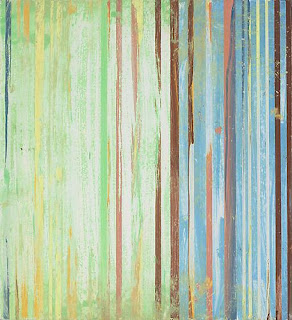The Death of Art and the Art of Death
What drives artists to destroy their chosen medium? Why "compose" noise? Why paint anti-paintings? Sure, old artistic conventions must be destroyed to create new ones. That is the dynamic of original creation. Strong poets "misread" their strong predecessors, is one way of putting it. But some artists seem bent on smashing not just conventions, but the medium itself. They want to strike at the fundamentals. So Ad Reinhard, who created his black paintings in the last decade of his life, wrote, "There is something wrong, irresponsible and mindless about color; something impossible to control. Control and rationality are part of my morality."
Michael Scott, whose solo exhibition I saw at the Gering & Lopez Gallery yesterday, was inspired by Reinhard to create his early series of "target" paintings. The series, consisting of black and white concentric circles that appear identical with only slight variations, was intended to remove "judgment" from the viewing experience. Then, even more radically, he created a series of black and white line paintings with the idea of making them so intensely optical that they would be impossible for the human eye to view. Anti-painting paintings. Why? There is something so mind-full about such projects that even their verbal descriptions repulse me. These projects set their mind against life. Unleavened by ironic play or sensual delight, they are animated by a spirit of denial. To call it spirit is to give it too much substance. Death is not a spirit; it is an absence of spirit.
Scott returns from the abyss to paint a series of color line paintings that, in the words of the press release, "embrace their own viewing rather than deny it." The exhibition title and then he tried to swallow the world sounds hubristic until I heard the relief in it. To go from black to psychedelic colors must feel like returning from the void to the world. The color lines are uneven, imperfect, wavy, and so show evidence of the human hand. The best of the paintings seem to vibrate, and even to move--from left to right, or from right to left, depending on how you see them--and to give the illusion of depth. Some appear possibly figurative to me, a patterned deckchair or faded fence. I like the smaller format better. My favorite is #4. It shows its materials: wood and enamel.
Since it was nearby, I visited Marian Goodman Gallery too. The exhibition As Long as it Lasts brings together works by fourteen artists to "ruminate on the transitory nature of life, the contemplation of mortality, impermanence, and immanence of death" (press release). Not a promising introduction, but I enjoyed two films there, and was intrigued by another.
An animated film-work, William Kentridge's "Tide Table" (2003) brings back waves of memories to an old gentleman looking out into the sea. The erasure of pencil-mark represents potently the loss of love and youth. Since that erasure also appears in the motion of a boy skipping a stone over water, it speaks of the inevitability of such losses.
The other piece, by Tacita Dean, is a film portrait of Mario Merz (2002), the Italian Arte Povera artist, seen here ruminating moodily under a tree in the final days of his life. The camera captures the weathered nobility of the artist's fine head. I thought: this is what those of us who would like to think of ourselves as artists come to--fodder for younger artists.
Lars Laumann's Berlinmuren, 2008, is more documentary than art. It records the love of two women for the Berlin wall, one of whom coined the term objectum-sexual in the 1970's to define her "marital" relationship to the wall. One woman loves the wall for what it was when it still stood as a divider between East and West Berlin. The other woman loves the wall for what it is: torn down and colored by graffiti. Both women denied their love had anything to do with politics. The division of the wall into what was and what is allows them to share their love for the same object.


Comments
Strong words! And I agree.